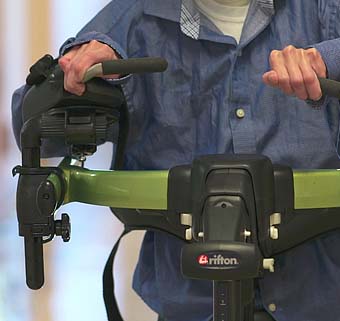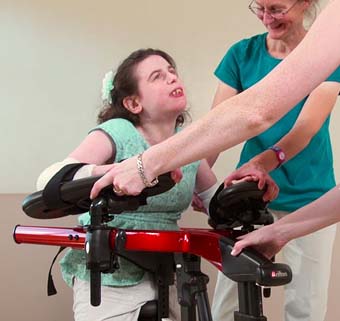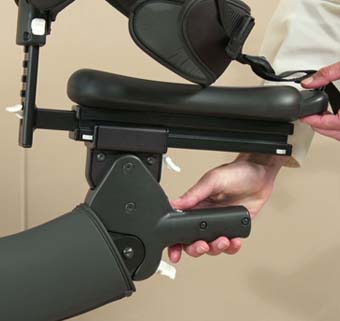Standers – What does the research say?
A webinar by Lori Potts, PT
This 30-minute webinar presented on January 18, 2018, gives an overview of current research on the topic of standing and adaptive standers as well as specific tips for therapeutic and functional use of Rifton standers.
Webinar Transcript
Welcome everyone. Thank you for signing up for this webinar. We will be looking at standers. As a colleague of mine has always enjoyed saying, “Standers are about the five B’s (Bone & joint, Bowel & bladder, Breathing, Blood, Brain).” But what we want to know today is how many of these are actually backed by research? What does the evidence say? We talk about cardiovascular, pressure relief, the upright posture for social development and vision. But what is actually there in the research?
Slide 3
There are different levels of evidence. The Center for Evidence-Based Medicine has an excellent chart delving into those facets of research. But it is important to know that the systematic review is your best top level of evidence, whereas your mechanism-based reasoning just inferring intervention with outcomes, is less.
Slide 4
So, as we think about this systematic literature review, the researchers have retrieved all the articles available and critically evaluated them. Then they synthesized that into something meaningful for the field.
Slide 5
Randomized-controlled trials are very important because in these studies, the subjects have an equal chance of being assigned to any of the study groups. So there is no even unintentional bias on the part of the researcher.
Slide 6
As we look at these systematic reviews, we discover that the evidence is moderately strong for the use of supportive standing for bone mineral density. It is also showing support for decreasing tone and improving range-of-motion. Those other benefits? Either the research has been done poorly or it is not statistically significant. In effect, inconclusive. This doesn’t mean those other benefits don’t exist, it is just that we need more research.
Slide 7
Today we are going to be looking particularly at these facets of the benefits of standing that have been borne out by research. And this 2013 systematic review actually puts out some clinical recommendations based either on the research or some expert opinion in order to give you ideas for timing, frequency and dosing.
Slide 8
Before we start, we just want to quickly refresh you with the gross motor function classification system. I particularly want to point out that levels I, II and III; those children are able to functionally walk, whereas levels IV and V, the children are more dependent.
Slide 9 & 10
Here we see children who are ambulating. Here we see children who rely on adaptive devices. This does make a significant difference in terms of development.
Tone
Slide 12
Let us talk about tone first. Already back in 1990, the research was done on children with cerebral palsy. We know they all have spastic cerebral palsy. We don’t exactly know the GMFCS level. (It hadn’t been developed at that time.) So we see that a half-hour prolong stretch is resulting in a reduction of tone. It is temporary but does last even beyond the stretch.
Slide 13
Twenty years later another study (this was looking at six children). They were ambulatory, however, they were provided the opportunity to stand in a prone stander. During those weeks of the study that they actually had the standing time, the gait measurements and the tone assessment showed improvement. There was a reduction of tone and the specific parameters of gait actually improved when they had that standing opportunity.
Notice the peak dorsiflexion angle improved. That could be considered a finding of range-of-motion. And that is what we are discussing next.
Joint ROM
Slide 15
Essentially, we see that standing can have an impact on contracture. These children have their knee extension range of motion measured. This was the same group of children but again they had a stretch of time of six weeks of PT alone and then another stretch of time, six weeks, of PT and standing. During those intervals of standing, their knee range of motion improved and actually decreased when they did not have the standing opportunity.
There were some care-giver reporting of ease of management of the children when they had the standing opportunity as well.
Slide 16
Now in saying this, we do need to make sure we don’t have our blinders on. We need to think bigger than simply range of motion and contracture and stretch. We have to recognize that it’s about muscle and muscle growth and physical activity.
And this is an excellent review because it reminds us that just like the osteopenia as it is seen in bones of children who are inactive, it is actually a result of that physical inactivity; similarly it may be that the contractures that we are seeing is actually due to muscle growth limitations and muscle strength limitations. So I invite you to read that article as well.
BMD
Slides 18 – 19
Now we will look at bone mineral density. This is one of the strongest evidence-based reasons to stand. We definitely know that children with CP present with low BMD and that is associated with fracture risk. A number of cohort studies have been done on this particular topic. This is where we have a larger population of children who are observed over time. With the prospective study, they start in the present and then they continue to follow them forward and compare those outcomes. With a retrospective study they are actually looking backward in time, to determine what factors may have influenced the outcomes.
But in every case, because it is a larger population of children, this is considered a higher level of evidence. It comes just under the systematic reviews in terms of levels of evidence.
Slides 20 – 21
Here we see a study where children were followed for nine years. The data that was collected involved GMFCS levels, gastrostomy tubes for feeding, and use of a standing device. They had some interesting findings including that children who were non-ambulatory who used standers had a four-fold reduction in fractures.
Slide 23
A meta-analysis used statistical methods to analyze multiple studies; it is a sub-set of a literature review. This 2017 meta-analysis confirms that weight-bearing exercise has a significant effect on improving bone mineral density.
Slide 24
Now in saying all of this, we need to take a closer look at that standing. Is it passive? Is it active? And a case-control study is when you have two groups of subjects and they are each exposed to different interventions. Then you compare those outcomes. This comes under cohort studies in terms of levels of evidence. But it is still valuable and provides information for us.
Slides 25 – 26
Here we see that children who are in a stander where the foot plates mimicked the movement of ambulation- that actually generated an improvement in bone mineral density. Yes, it was a small study. The numbers of children were small but it is exciting to see these findings. And it underscores that the forces experienced during ambulation are important.
Slide 27
Now a case series is where there is no control involved. You are simply observing outcomes with a particular group. This next study is actually an observational study about how much weight-bearing is happening with students in standers. I’m not sure that we can really categorize it as a case series but it is very interesting.
Slide 28
What happened is young adults and children of GMFCS levels of IV and V were placed in a Rifton Supine Stander and in an Easy Stand. The same subject was assessed in each stander. There were special load-measuring foot-plate adapters that could assess the amount of weight-bearing that was happening. Interestingly, there was quite a difference in terms of actual weight-bearing in the standers. So this reminds us that in our positioning of students in standers, we need to make sure that weight-bearing is actually happening.
Hip Stability
Slides 30 – 32
Now we will discuss hip stability. It is certainly widely known that children, particularly non-ambulatory children with CP, are susceptible to hip displacement. In fact, one study showed that up to 90% of children of Level V were experiencing this. So, as we notice this happening, even with very young children, and predominantly with spastic CP, we need to consider what are the factors involved here.
Slide 33
Sweden particularly, has been a forerunner in looking at this more closely. They have published both a ten-year study and a twenty-year time-span, cohort study. They are finding that indeed this is a high-risk population.
Slide 34
When we talk about migration percentage, we are talking about the displacement of the head of the femur relative to the acetabulum. So the higher the portion of the head of the femur beyond the acetabulum, the greater the migration percentage until you have a 100% when it is completely dislocated.
Slide 35
In 2009 Robin gave a classification where he put together his view that beyond 30% would be considered subluxed.
Of course every researcher will define the migration percentage as a way of showing that displacement.
Slides 36 – 37
This study was looking at children to find what are the factors that would predict developing that migration percentage within five years of that first X-ray. Interestingly, the factors were the migration percentage and the head shaft angle. So, the coxa valga at the hip as well as the GMFCS level. These played out in terms of high MP. Clinically evaluated hip range of motion? - not so much.
Slide 38
So Robin is looking at, again, these same factors of the hip; the femoral neck ante version and the neck shaft angle. And these are found to be related to displacement of the hip.
Slides 39 – 41
What is fascinating about his work is that you can see the correlation between Level I up to Level V with an increasingly worsening deformity with that weight-bearing not being present and that muscle action at the hip not being present as happens with gait. That is just a stepwise fashion - quite impressive and thought-provoking and definitely leads us to consider the shape of that proximal femur as being related to delayed walking and a key factor in dislocation.
Slide 42
In fact, this study which is about adductor spasticity and use of a hip abduction brace concluded, in the end that it’s this bony deformity that may have a high rate of influence.
Slides 43 – 45
And if we think about the idea of passive optimal positioning, as shown by this standing shell developed in Sweden, there is no movement. There is no active, physical movement at the joint. And interestingly they found that this non-dynamic weight-bearing did not affect bone mineral density and in fact possibly or did indeed, worsen hip displacement. In their study, these were children who didn’t have the opportunity to use botulinum toxin, so their adductor muscles were quite spastic. And possibly those forces were stronger as the child was in the immobile position. So these are certainly considerations.
Slides 46 – 47
Here on the flip side we see a study where they actually had straddled abducted weight-bearing. And this was a fairly high number of children. More of these children were in the control groups than were in the study groups. But basically you can see the numbers there. Some of the children were post-hip surgery with abductive standing; others were abductive standing only, potentially as a preventative measure for surgery.
Slide 48
We do know that children with greater than 40% migration percentage are sometimes advised to undergo an adductor-ileopsoas tenotomy, and that is what the surgery was in this case.
Slide 49
And the findings were that certainly those in the abductive standing group had less migration percentage.
Of course, we have to realize that there are weaknesses of the study. For example, use of botulinum toxin was not controlled by either group and potentially that aided the tolerance for the abducted position. Also, there were more children in the control group which may have skewed the number of adverse outcomes in that particular study group. But, essentially we definitely recognize the importance of abduction. The researchers themselves say larger studies are needed to confirm the results.
Slide 50
So what does all of this tell us? Postural management matters. And there have been various consensus and guidelines on posture management already, over years.
Slides 51 – 54
There are resources available with recommendations, some of which are linked directly to the research in terms of positioning for these children to optimize their outcomes conservatively. Of course it is an approach that also will involve surgery as needed. And importantly, we need to think in terms of activity, environment, participation; looking far beyond simply body structure and function for these children.
Slide 55
This brings us to the ICF. We cannot have a PT presentation without including the ICF. So there is a great learning tool on-line to learn more there.
Slide 57
As we think beyond standing, we want to consider walking. This study actually looked at children and found that it was sit-to-stand that predicted walking. There is a big difference between transitioning from sitting to standing and being placed in a passive standing position.
Slides 59 – 60
And we also need to consider the young people’s use of standers and what is important to them; their attitudes, the challenges they face. And this is a very nice study that you can read which is free on-line text, to learn more from the young people’s perspective.
Slides 61 – 63
So, as we wrap up our discussion, we think about the fact that the reduced tone should lead us into activities that would benefit from that reduction. Think about longer standing periods for ROM benefits. And we should not forget the importance of active muscle use as well. And then bone mineral density, assuring that the weight-bearing is truly occurring; perhaps incorporating sit-to-stand as beneficial as well.
Slides 64 – 65
Definitely consider hip stability for your children with spasticity who are non-ambulatory. This is a little tip showing how 60 degrees is, in fact, an isosceles triangle. So we are talking about a considerable amount of abduction in order to achieve 60 degrees at the hip.
We are now going to move from this segment to actually looking at some equipment; some of our Rifton products. So stay with me.
Related Resources:
You may find these additional related resources of interest.
Functional Applications
Benefits of Classroom Standing
Choosing Between Adaptive Standers
Increasing Hip Abduction Range on Rifton’s Small Prone Stander
Evidence-Based Practice
Adaptive Standers and Bone Mineral Density
Dynamic Standing vs. Passive Standing Interventions
Standing Programs for Hip Flexibility
Funding







